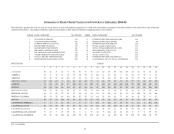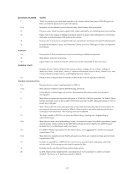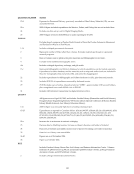7
materials in their hands for longer periods of time. Keeping the material in the hands of the users also
alleviates the space demands made on libraries by the continuing growth of their collections.
Graph 1 indicates that, since 1991, certain service areas are increasing whereas others are decreasing
their activity levels. Overall, library staffing has remained roughly constant. Starting in 1996 circulation
service transactions began to decline, in 1998 reference transactions began to fall, and in 2000 both categories
dropped below 1991 levels for the first time. The median of group presentations increased to a new record
high of 806 in 2003, and nearly matched that high with 803 in 2004‐05. Meanwhile, the number of
participants in those presentations continues to increase, with 13,034 participants for the typical research
library. Interlibrary borrowing has also grown constantly since 1991, by an average of 1,096 transactions per
year.
A variety of explanations have been voiced regarding the decline of the number of reference
transactions. Many libraries are making a concerted effort to examine the changing user needs that impact
reference services in general. Heavy users of library materials and services may make less use of in‐person
reference services than did such users in the era before the availability of online catalogs, remote access to
indexing and abstracting databases, and electronic full‐text resources delivered at the desktop. Often, those
people who do approach reference librarians require more assistance than before. At the same time, virtual
reference services are adding another dimension to the growing complexity of responding to reference
questions. Libraries have instituted initiatives with a deliberate emphasis on direct contact between subject
specialists and departments (shifting research consultation activity away from desk‐based service). Thus, a
simple count where each reference question gets a single “tally” cannot capture the varying dimensions and
growing complexities of reference services. While patterns of behavior are changing and there is a decline in
reference transactions, 66,300 questions per year are still made in the median ARL library.
Demand for library user education has been high recently. As seen in Graph 1, group presentations
have risen by 58% since 1991, participants in these presentations by 93%, and interlibrary borrowing by
147%. Perhaps of most interest is the fact that by 2005, about one‐third of the presentations conducted in a
typical ARL library had been added since 1991. The typical ARL library offered 803 “teaching” sessions in
2004‐05. If we assume that each session was at least an hour long, then the median ARL library offered the
equivalent of 22 three‐hour credit courses last year. Since a median number of 13,782 people received formal
education through library instruction in a typical ARL library, those 803 “teaching” sessions averaged about
17 attendees. Information literacy has become an important program area for libraries and the Association of
College and Research Libraries (ACRL) has developed widely used ʺInformation Literacy Competency
Standards for Higher Education.”11 Efforts are underway through the ARL New Measures Initiative to
define how libraries contribute to student learning outcomes from a user‐centered perspective.
11 http://www.ala.org/acrl/ilcomstan.html.
materials in their hands for longer periods of time. Keeping the material in the hands of the users also
alleviates the space demands made on libraries by the continuing growth of their collections.
Graph 1 indicates that, since 1991, certain service areas are increasing whereas others are decreasing
their activity levels. Overall, library staffing has remained roughly constant. Starting in 1996 circulation
service transactions began to decline, in 1998 reference transactions began to fall, and in 2000 both categories
dropped below 1991 levels for the first time. The median of group presentations increased to a new record
high of 806 in 2003, and nearly matched that high with 803 in 2004‐05. Meanwhile, the number of
participants in those presentations continues to increase, with 13,034 participants for the typical research
library. Interlibrary borrowing has also grown constantly since 1991, by an average of 1,096 transactions per
year.
A variety of explanations have been voiced regarding the decline of the number of reference
transactions. Many libraries are making a concerted effort to examine the changing user needs that impact
reference services in general. Heavy users of library materials and services may make less use of in‐person
reference services than did such users in the era before the availability of online catalogs, remote access to
indexing and abstracting databases, and electronic full‐text resources delivered at the desktop. Often, those
people who do approach reference librarians require more assistance than before. At the same time, virtual
reference services are adding another dimension to the growing complexity of responding to reference
questions. Libraries have instituted initiatives with a deliberate emphasis on direct contact between subject
specialists and departments (shifting research consultation activity away from desk‐based service). Thus, a
simple count where each reference question gets a single “tally” cannot capture the varying dimensions and
growing complexities of reference services. While patterns of behavior are changing and there is a decline in
reference transactions, 66,300 questions per year are still made in the median ARL library.
Demand for library user education has been high recently. As seen in Graph 1, group presentations
have risen by 58% since 1991, participants in these presentations by 93%, and interlibrary borrowing by
147%. Perhaps of most interest is the fact that by 2005, about one‐third of the presentations conducted in a
typical ARL library had been added since 1991. The typical ARL library offered 803 “teaching” sessions in
2004‐05. If we assume that each session was at least an hour long, then the median ARL library offered the
equivalent of 22 three‐hour credit courses last year. Since a median number of 13,782 people received formal
education through library instruction in a typical ARL library, those 803 “teaching” sessions averaged about
17 attendees. Information literacy has become an important program area for libraries and the Association of
College and Research Libraries (ACRL) has developed widely used ʺInformation Literacy Competency
Standards for Higher Education.”11 Efforts are underway through the ARL New Measures Initiative to
define how libraries contribute to student learning outcomes from a user‐centered perspective.
11 http://www.ala.org/acrl/ilcomstan.html.


















































































































































